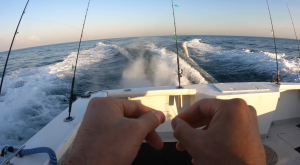
Master These 5 Knots Every Angler Should Know
Knowing how to tie strong fishing knots is one of the most important skills for any angler. A well-tied knot ensures your hook or lure
Choosing the right fishing reel can significantly impact your fishing experience, especially if you’re a beginner or intermediate angler. With various options available, it’s important to understand the strengths and weaknesses of each type of reel before making a decision and spending your hard earned money. And with that said, remember a fishing reel is the least important tool in your fishing tool box, with your line selection and rods selections being far more important (offshore fishing reels are the exception to this rule). So, don’t over think it too much and don’t spend a ridiculous amount of money on your reels. This guide will break down the most common reel types, their pros and cons, and how to choose the best one for your next fishing trip.
Spinning reels are among the most popular and versatile options for beginners and intermediate anglers. They are easy to use and work well for a variety of fishing environments, including freshwater lakes, rivers, ponds, inshore saltwater fishing, and offshore fishing environments. They literally can do it all and catch any fish from ultralight fishing in ponds to tuna fishing way offshore.
Best for: Beginners to intermediate anglers
Pros:
Cons:
Baitcasting reels are favored by experienced anglers who require greater accuracy and control with their casting. The reel advantage of baitcasting reels is the control you get on your casts from being able to feather your line with your thumb resulting in greater accuracy with your casts. Feathering your line simply means you are putting varying degrees of pressure on your spool with your thumb as you cast, both preventing backlashes and ensuring accuracy of each cast.
Best for: Intermediate to advanced anglers, precision casting
Pros:
Cons:
Spincast reels are designed for ease of use, making them perfect for kids and those new to fishing. They feature a push-button mechanism and a closed-face design to prevent line tangles. For beginners and children, the key advantage to a spincast reel is how easily you can learn the timing of letting go of the line for a quality cast. This gained experience in learning how to cast will serve any beginner extremely well as they advance to intermediate level fishing reels. These reels are also inexpensive making them perfect for a true beginner fishalot out there.
Best for: Absolute beginners, children, casual fishing
Pros:
Cons:
Conventional reels are often built for heavier applications of fishing in strong currents, offshore environments, or fishing at deeper depths. These reels offer heavy-duty performance for catching any fish out of demanding fishing environments. These reels often hold far more line than any other reel and are meant for the toughest fishing conditions for larger fish.
Best for: Offshore fishing, deep-sea angling, big game species, trolling heavy lures or baits
Pros:
Cons:
Before purchasing a reel, consider the following factors to ensure you select the best option for your needs:
Selecting the right fishing reel can make all the difference in how you enjoy your day out on the water. Beginners will find spinning or spincast reels more user-friendly, and they will find their day far more enjoyable not dealing with backlashes or tangles, while intermediate and advanced anglers may prefer baitcasting or conventional reels for better precision and power. By understanding the pros and cons of each reel type and considering your fishing environment, you’ll be well-prepared to make the perfect choice for your next trip.
You can refer to my “Shop Gear” page for recommended breakdowns of fishing reels and rods for beginners, intermediate, and expert fishalots!!

Knowing how to tie strong fishing knots is one of the most important skills for any angler. A well-tied knot ensures your hook or lure

Winter fishing can be one of the most rewarding experiences for anglers, with fewer crowds, stunning winter landscapes, and the chance to catch trophy-sized fish.